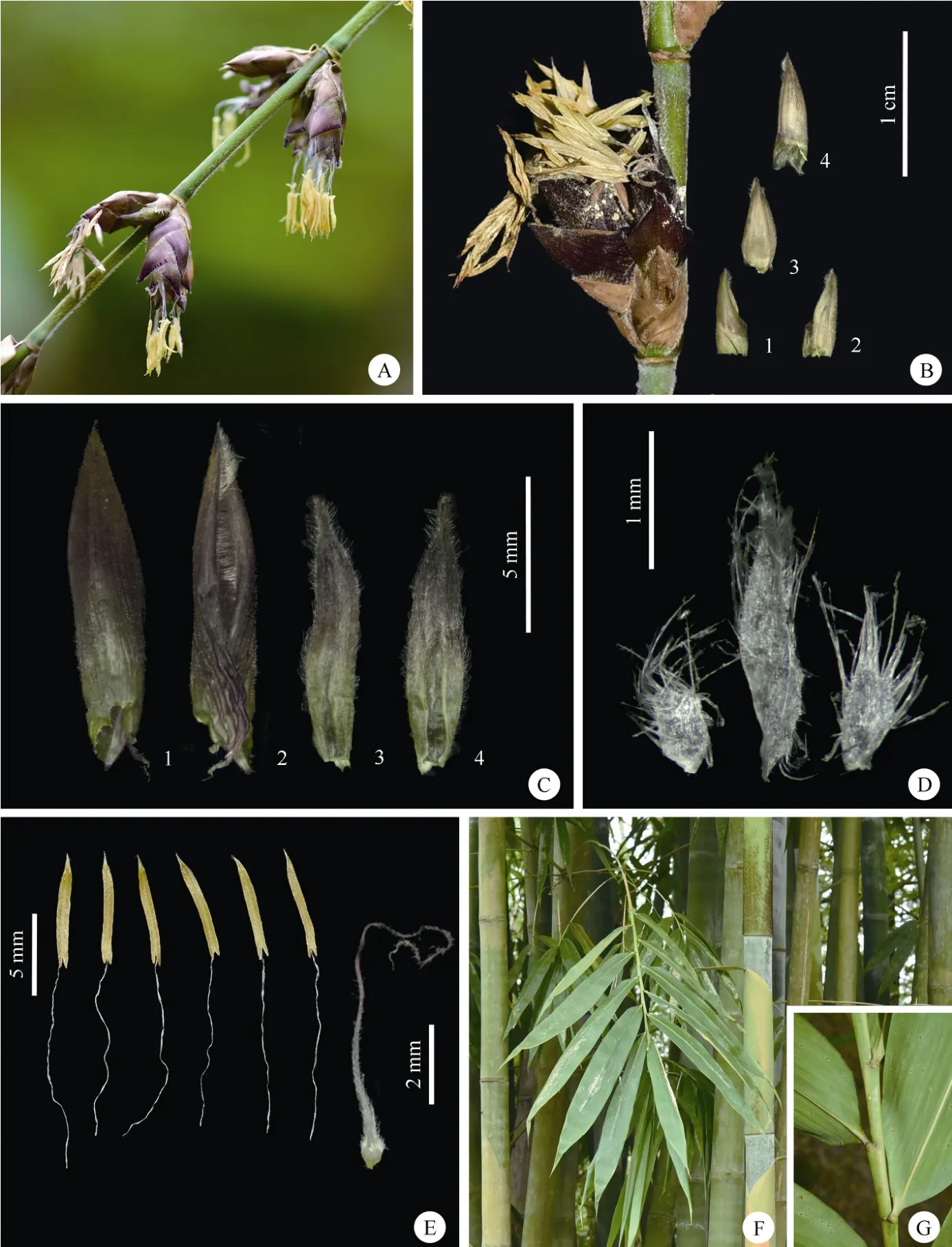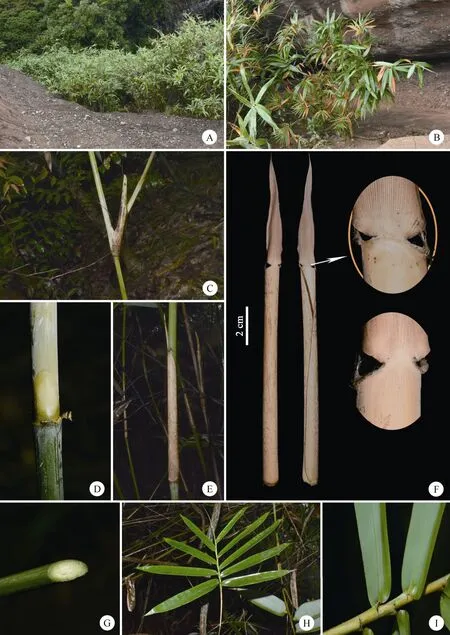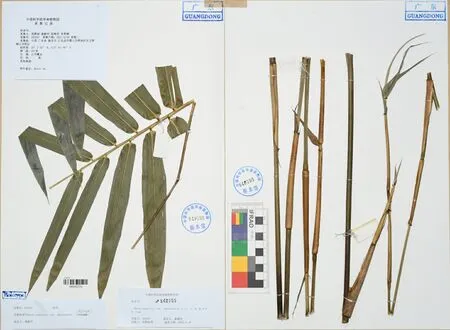A New Bamboo Variety from Danxia Mountain and Morphological Supplement to Dendrocalamus pulverulentoides
2022-12-17LIXingNIJingboCHENZaixiongTONGYihua
LI Xing,NI Jingbo,CHEN Zaixiong,TONG Yihua*
(1.Key Laboratory of Plant Resources Conservation and Utilization & Guangdong Provincial Key Laboratory of Digital Botanical Garden, South China Botanical Garden, Chinese Academy of Sciences, Guangzhou 510650,China; 2. South China National Botanical Garden, Guangzhou 510650,China;3.University of Chinese Academy of Sciences,Beijing 100049,China; 4. Administrative Commission of Danxia Mountain National Park,Shaoguan 512300,Guangdong,China)
Abstract: Bonia saxatilis var.danxiaensis,a new variety from Danxia Mountain National Nature Reserve is described and illustrated.It differs from the nominate variety by having ligules of both culm and foliage leaves without long cilia on the margin.The key to the varieties of Bonia saxatilis is provided here.We also emend the descriptions of some vegetative characters and provide a supplementary description of floral morphology for another species newly described from Danxia Mountain,Dendrocalamus pulverulentoides.
Key words: Bambusoideae; Renhua County; Bonia saxatilis var.solida
BoniaBalansa is a small bamboo genus with five species and one variety endemic to South China except thatB.tonkinensisBalansa is distributed in North Vietnam[1–6].Two species ofBonia,viz.B.saxatiis(L.C.Chia,H.L.Feng & Y.L.Yang)N.H.Xia andB.parvifloscula(W.T.Lin) N.H.Xia,are recorded from Guangdong Province[2,4].
In 2021,we conducted two bamboo surveys to Danxia Mountain and discovered three populations of an unknownBoniaspecies.This species resemblesB.saxatilisin having white powdery internodes,and culm leaves with abaxially white-puberulent and brown-tomentose sheaths,developed auricles and similar blades,and the only difference is that the ligules of both culm and foliage leaves of the plants from Danxia Mountain do not possess long cilia on the margin.Therefore,we determined that the plants from Danxia Mountain should represent a new variety ofB.saxatilis,which is described and illustrated below.
Besides,we also noticed that in the protologue[7]of another newly described species from Danxia Mountain based on sterile material,namelyDendrocalamus pulverulentoidesN.H.Xia,J.B.Ni,Y.H.Tong& Z.Y.Niu,some descriptions and photos (Fig.3 : F,G) of foliage leaves do not belong to this species,and the living collections of this species in South China Botanical Garden blossomed in October 2021.Thus,the emended description of foliage leaves (see the underlined content below) and supplementary description of floral morphology of this species were also provided.

Fig.3 Dendrocalamus pulverulentoides.A: Part of flowering branch; B: Cluster of pseudospikelets,abaxial (1) and adaxial (2) view of prophyll,gemmiferous bract (3),glume (4); C: Abaxial (1) and adaxial (2) view of lemma,abaxial (3) and adaxial (4) view of palea; D: Lodicules; E: Stamens and pistil; F: Foliage leafy branch and partial culm; G: Part of foliage leafy branch,showing sheath and ligule.(Photos F & G by Zhuo-yu Cai,others by Xing Li)
Bonia saxatilis var.danxiaensisX.Li,J.B.Ni& Y.H.Tong,var.nov.(Fig.1)

Fig.1 Bonia saxatilis var.danxiaensis.A: Habitat; B: Habit; C: Solitary branch complement; D: Culm bud; E–F: Culm leaves; G: Oblique section of culm,showing spongy pith; H: Foliage leafy branch; I: Part of foliage leafy branch,showing sheath and ligule.(Photos A,B,D,I by Zhuo-yu Cai,F by Xing Li,others by Yi-hua Tong)
Type:China.Guangdong Province: Shaoguan City,Renhua County,Danxia Mountain National Nature Reserve,near the top of Yuping Peak,25°1′32″ N,113°45′30″ E,elev.241 m,20 April 2021,J.B.Ni et al.DXS037 (holotype: IBSC0884276,isotypes: IBSC0884277,IBSC0884278)
Diagnosis:Bonia saxatilisvar.danxiaensisdiffers from its nominate variety by having ligules of both culm and foliage leaves without long cilia on the margin,and can be distinguished fromB.saxatilisvar.solida(C.D.Chu & C.S.Chao)D.Z.Liby having ligules of both culm and foliage leaves without long cilia on the margin and culm leaves with abaxially white-puberulent and brown-tomentose sheaths.
Shrubby bamboos.Rhizomes pachymorph,shortnecked.Culms erect,sometimes scandent,2–4 m tall,3–7 mm in diameter; internodes terete,slightly swollen on infranodal region,30–45 cm long,glabrous,whitepowdery,especially on infranodal region; pith spongy;nodes flat or slightly prominent,glabrous; supranodal ridge flat; intranodes 5–10 mm tall,glabrous; branches solitary,nearly as thick as culms,0.5–1.5 m long;culm bud solitary,elliptic,pale yellow,puberulent abaxially,ciliolate on the upper margin,apex rounded.Culm leaf sheath persistent,thinly leathery,rigid,1/5–2/5 as long as internodes,white-puberulent and browntomentose abaxially,sometimes glabrescent,margin densely brown ciliate,longitudinal ribs conspicuous;sheath scar with remains of sheath base; auricles oblong to falcate,amplexicaul,recurved,slightly unequal,4–7 mm×1–2 mm; oral setae erect or slightly curved,radiating,3–10 mm long; ligule serrate,ca.0.5 mm tall,glabrous,apex truncate; blades lanceolate,usually erect,rarely reflexed,not amplexicaul,3/10–1/2 as long as sheath,glabrous,base subcordate or slightly narrowed.Foliage leaves 9–13 per ultimate branch;sheath leathery,rigid,7–9 cm long,white-puberulent and brown-tomentose abaxially,glabrescent when old,margins densely brown-ciliate,sometimes glabrous,thinly white-powdery,longitudinal ribs conspicuous;auricles elliptic to falcate,1.5–3 mm×1–1.5 mm,easily deciduous when old; oral setae erect or curved,1–7 mm long,usually deciduous when old; inner ligule 1–2 mm tall,glabrous or sometimes densely ciliolate on margin,apex truncate,serrate; outer ligule 1–2 mm tall,glabrous,sometimes ciliolate on the margin; blades lanceolate to oblong-lanceolate,papyraceous,12.5–30 cm×1.5–4.5 cm,glabrous adaxially,sparsely puberulous along midveins abaxially,usually glabrescent when old,apex acute to attenuate,base truncate to slightly oblique,margin entire; secondary veins 6–10 pairs,transverse veins inconspicuous;petioles 2–4 mm long,glabrous.Inflorescence unknown.
Phenology:New shoots from April to October.
Distribution and habitat:This new variety is currently only found in the type locality,Danxia Mountain National Nature Reserve in Renhua County of Guangdong Province.It commonly grows on the shrubland or hillsides exposed to the sun at elevations of 200–300 m.
Etymology:The epithet refers to the type locality,Danxia Mountain.
Chinese vernacular name: 丹霞单枝竹(pinyin:dān xiá dān zhī zhú).
Additional specimens examined (paratypes):CHINA.Guangdong Province,Shaoguan City,Renhua County,Danxia Mountain National Nature Reserve:near the top of Qianban Peak,25°0′37″ N,113°43′59″E,elev.254 m,16 October 2021,J.B.Ni et al.DXS048 (IBSC); Shangtianlong,25°0′29″ N,113°41′17″ E,elev.301 m,17 October 2021,J.B.Ni et al.DXS054 (IBSC).
Key to varieties of Bonia saxatilis
1a.Culm leaf sheath white-puberulent and brown-tomentose abaxially.
2a.Ligules of both culm and foliage leaves with long cilia on the margin·························································var.saxatilis
2b.Ligules of both culm and foliage leaves without long cilia on the margin·················································var.danxiaensis
1b.Culm leaf sheath abaxially glabrous···································································································var.solida

Fig.2 Holotype of Bonia saxatilis var.danxiaensis (J.B.Ni et al.DXS037,barcode: IBSC0884276)
Dendrocalamus pulverulentoidesN.H.Xia,J.B.Ni,Y.H.Tong & Z.Y.Niu
Description:Arborescent bamboo,rhizomes pachymorph,short-necked.Culms erect,8–10 m tall,ca.8 cm in diameter,pendulous apically; internodes terete,25–35 cm long,initially covered with thick white powder; nodes conspicuous; both the infranodal and intranodal regions covered with a 5 mm wide band of brown sericeous hairs; culm wall ca.1 cm thick; branches developing from 10th to 13th nodes upwards,ca.4 m above ground,inclined at an angle of 45°–60° with the culm,several at each node,the central one dominant; primary branch buds broadly ovate,not sunken into culm internode surface.Culm leaf sheath caducous,thickly leathery,initially yellowish-green,brown when dry,22.5–28.5 cm×29.5–45 cm,apex concave,abaxial surface with the middle and lower parts densely appressed-brownsetose and thinly white-powdery,with several yellowishwhite vertical stripes near the margin,stripes inconspicuous when dry,margin deciduously white-ciliate;sheath scar prominent,with persistent remains of sheath base; auricles narrowly elliptic,ca.2 mm long and 0.5 mm wide; oral setae 1–5 mm long; ligule ca.2 mm tall,serrulate,apex concave and densely ciliate,cilia fragile and easily broken off,serrations with ciliolate margin; blades reflexed,ovate-lanceolate,usually sinuous,3–6 cm×1–1.5 cm,ca.1/5 as long as sheath,base 1/2–2/3 as wide as sheath apex,middle and upper parts involute,adaxially brownhispid at the base,abaxially glabrous.Foliage leaves 7–12 per ultimate branch; sheath glabrous,with conspicuous longitudinal ribs,margin glabrous or sometimes ciliolate; auricles and oral setae absent;inner ligule ca.1.5 mm tall,serrulate,margin glabrous,sometimes ciliolate,apex truncate; outer ligule ca.1 mm tall,glabrous; blades linear-lanceolate to lanceolate,papyraceous,20–38 cm×2–5.5 cm,both surfaces glabrous,margin serrulate,apex attenuate,base attenuate to obtuse; secondary veins 6–10 pairs,transverse veins inconspicuous; petioles ca.5 mm long.Pseudospikelets sessile,3 or more fasciculate at nodes of flowering branch,ovate to elliptic,purplish to purple,1–1.5 cm×ca.1 cm; prophylls ovate to broadly lanceolate,5–6 mm long,1-keeled,ciliate on keels,puberulous abaxially; gemmiferous bracts 1,lanceolate,5–7 mm×2–3 mm,8-veined,puberulous abaxially,densely ciliate on the margin,apex acute;florets 4 or 5; rachilla extremely short,ca.0.5 mm long; empty glume usually 1,lanceolate,7–9 mm long,11-veined,puberulous abaxially,densely ciliate on the margin,apex acute to mucronate; lemma purplish to purple on the upper part,light green at the lower part,lanceolate,10–12 mm long,18-veined,puberulous on both sides,densely ciliate on the margin,apex acute to mucronate; palea lanceolate,ca.9 mm long,2-keeled,3-veined between keels,2-veined outside keels,densely ciliate on keels,puberulous abaxially and adaxially; lodicules 3,unequal,anterior 2 ovate to elliptic,ca.0.5 mm long,posterior 1 lanceolate,ca.1.5 mm long,ciliate on the margin;stamens 6,filaments white,slender,1–1.5 cm long,anthers yellow,5–8 mm long,ciliolate at the attenuate apex; ovary ovoid,base stalked,glabrous on the lower part,puberulous at apex; style together with stigma ca.1 cm long.New shoots from July to September.Flowering from October to next March,mature caryopsis unknown.
Additional specimens examined:CHINA.Guangdong Province,Shaoguan City,Renhua County,Danxia Mountain National Nature Reserve: near Chenwan Village,25°1′52″ N,113°42′33″ E,elev.66 m,25 September 2020,J.B.Ni et al.DXS025 (holotype IBSC0859799,isotype IBSC0859798); near the Huangkeng Town,elev.88 m,15 October 2021,J.B.Ni et al.DXS042 (IBSC); introduced from Danxia Mountain,cultivated in South China Botanical Garden,1 November 2021 (fl.),Xing Li LX100 (IBSC0884279).
AcknowledgmentsWe also appreciate Zheng-yang Niu,Zhi-xian Zhang,Zhuo-yu Cai,Zhi-chu Li and the staff of Danxia Mountain Nature Reserve for their help during field trips.
